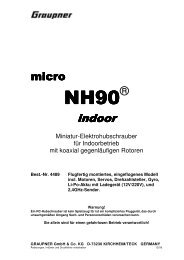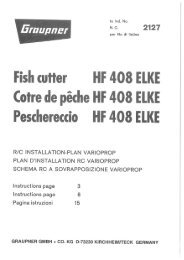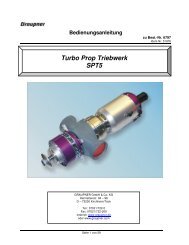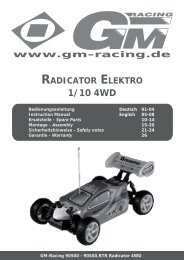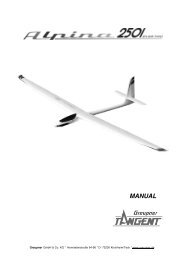ULTRAMAT 14 plus - Graupner
ULTRAMAT 14 plus - Graupner
ULTRAMAT 14 plus - Graupner
You also want an ePaper? Increase the reach of your titles
YUMPU automatically turns print PDFs into web optimized ePapers that Google loves.
2. Warnings and safety notes<br />
This product isn‘t designed for use by children under the age of <strong>14</strong>, it isn‘t a toy!<br />
Protect the charger from dust, damp, rain, heat (e.g. direct sunshine) and vibration. It should only be<br />
operated in dry indoor conditions.<br />
The case slots serve to cool the charger, and must not be covered or enclosed; set up the charger<br />
with space round it, so that cooling air can circulate unhindered.<br />
The charger is designed to be powered by a 12 V DC car battery or power supply or 100~240V AC<br />
main socket only. It is not permissible to modify the charger in any way. Never use both inputs AC and<br />
DC at the same time!<br />
The charger and the battery to be charged should be set up on a heat-resistant, non-inflammable<br />
and non-conductive surface before use. Never place the charger directly on a car seat, carpet or<br />
similar. Keep all inflammable and volatile materials well away from the charging area. Provide good<br />
ventilation. Defective batteries can explode or burn!<br />
Connect the charger 12DC input directly to the car battery using the original cables and connectors<br />
supplied. The car’s engine must be stopped all the time the Charger is connected to the car’s battery.<br />
Do not recharge the car battery at any time when the Charger is connected to it.<br />
The charge output sockets and connecting leads must not be modified, and must not be interconnected<br />
in any way. There is a danger of short-circuit between the charge outputs and the vehicle’s<br />
bodywork when the charger is connected to the car battery. The charge leads and connecting leads<br />
must not be coiled up when the charger is in use. Avoid short-circuiting the charge output or the<br />
model battery with the car bodywork. For this reason the charger must never be placed directly on the<br />
vehicle’s bodywork.<br />
Never leave the charger running or connected to the car battery unsupervised.<br />
Only one battery may be connected to the unit for charging at any one time.<br />
The following types of battery must not be connected to the charger:<br />
- Ni-Cd / Ni-MH batteries consisting of more than <strong>14</strong> cells, Lithium-Ion / Li-Mn / Lithium-Polymer /<br />
LiFePO 4 (LiFe) batteries of more than 6 cells, or lead-acid batteries with a nominal voltage of more<br />
than 12V.<br />
- Batteries which require a different charge method from Ni-Cd, Ni-MH, Lithium or lead-acid types.<br />
- Faulty or damaged cells or batteries.<br />
- Batteries consisting of parallel-wired cells, or cells of different types.<br />
- Batteries consisting of old and new cells, or cells of different makes.<br />
- Non-rechargeable batteries (dry cells). Caution: explosion hazard!<br />
- Batteries which are not expressly stated by the manufacturer to be suitable for the currents which<br />
this unit delivers during the charge process.<br />
- Packs which are already fully charged or hot, or only partially discharged.<br />
- Batteries or cells fitted with an integral charge circuit or charge termination circuit.<br />
- Batteries installed in a device, or which are electrically connected to other components.<br />
To avoid short-circuits between the banana plugs fitted to the charge leads, please always connect<br />
the charge leads to the charger first, and only then to the battery to be charged. Reverse the sequence<br />
when disconnecting.<br />
As a basic rule always check that the charge quantity is approximately the same as you expected after<br />
the charger has indicated that the pack is fully charged. This is a simple method of detecting a problem<br />
reliably and in good time, should the charge process be terminated prematurely for any reason. The<br />
likelihood of premature termination varies according to many factors, but is at its highest with deepdischarged<br />
packs, low cell counts and particular cell types which are known to cause problems.<br />
We recommend that you carry out a series of test charges to satisfy yourself that the automatic<br />
termination circuit is working perfectly. This applies in particular when you are charging packs consisting<br />
of a small number of cells. If the cells feature has a poorly defined voltage peak, the charger may fail<br />
to detect the fully charged state.<br />
Before charging please check: have you selected the appropriate charge program for the battery?<br />
Have you set the correct charge or discharge current? Have you set the important cut-off voltage<br />
when charging Ni-Cd and Ni-MH packs? Are all connections firm, or is there an intermittent contact at<br />
any point in the circuit? Please bear in mind that it can be dangerous to fast-charge batteries. For<br />
example, if there is a brief interruption due to an intermittent contact, the result is inevitably a<br />
malfunction such as a restart of the charge process, which would result in the pack being massively<br />
overcharged.<br />
25



